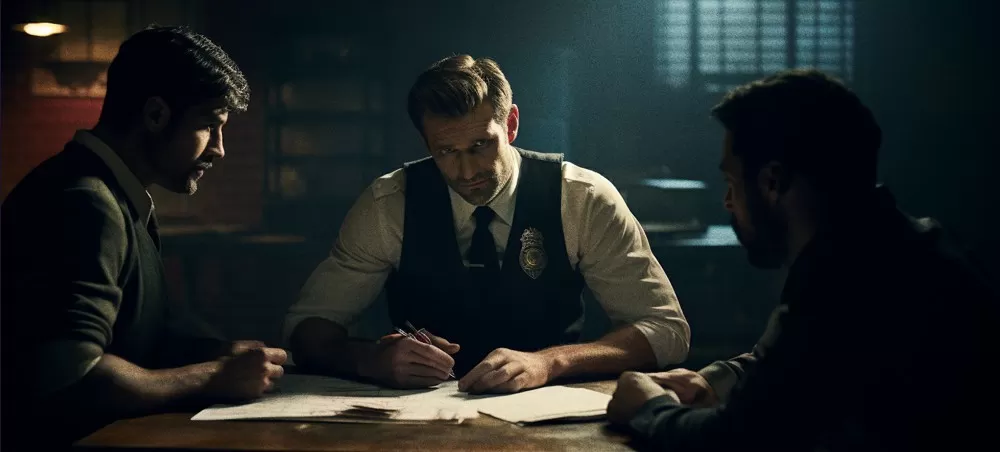
Ah, the art of dialogue, the dance of words, the symphony of conversation... It's a topic that's been dissected, analyzed, and celebrated in countless ways. But today, dear reader, we're diving into the rules of dialogue. Buckle up, grab your popcorn, and prepare for a rollercoaster ride through the world of words, wit, and wisdom.
The Good Cop, Bad Cop Routine
Imagine a scene where a cop is interrogating a criminal. The cop threatens, the criminal laughs, and the scene unfolds with a dance of tactics. It's the classic good cop, bad cop routine. But what makes it engaging? It's the dynamic interplay, the shifting strategies, the battle of wits. It's like watching a chess match where each player is trying to outmaneuver the other. Checkmate!
Want to write characters that play mind games like a seasoned detective? Here are a few pointers on how to do it:
1) Define Roles: Decide who's the good cop (buttering up the suspect) and who's the bad cop (grilling them like a summer BBQ).
2) Create Conflict: Let them clash, argue, and throw metaphorical pies at each other.
3) Switch It Up: Have them change roles mid-scene for a twist that'll leave readers' heads spinning.
4) Add a Doughnut: Because every cop scene needs a doughnut. It's the law.
The Art of Rapid-Fire Dialogue
Remember the opening scene of "The Social Network"? Mark Zuckerberg's desperate attempts to impress his girlfriend, her squirming discomfort, the battle of words?
This is a masterclass in dialogue written by Aaron Sorkin. Each character is trying different tactics, from shaming to ridiculing, to win the conversation. It's a dance, a duel, a drama. And it's all in the dialogue. If you want to create dialogue like that, here are a few pointers:
1) Speed It Up: Have characters talk over each other, interrupt, and generally act like caffeinated squirrels.
2) Add Wit: Sprinkle in clever comebacks, witty one-liners, and zingers that zing.
3) Keep It Moving: No pauses, no breaths, no mercy. Go, go, go!
4) Include a Disclaimer: Warning, may cause readers to hyperventilate.
The Desire to Be Right
Sometimes, dialogue is not about lofty goals or grand desires. Sometimes, it's just about being right. Take the scene between two hitmen in "Pulp Fiction," discussing foot massages. It's not about life and death; it's about winning the conversation. It's real, it's raw, it's relatable. And it's hilarious.
Arguing about foot massages or the correct pronunciation of "tomato"? Here's how to do it and win every time:
1) Pick a Silly Subject: The more trivial, the better.
2) Let Them Bicker: Like old married couples or internet commenters.
3) Add Passion: They must care about this banana-peeling method as if their lives depended on it.
4) Resolve Nothing: Because where's the fun in that?
The Power of Subtext
Subtext is, without doubt, the mysterious underbelly of dialogue. It's the text underneath the text, the hidden meaning, the unspoken truth. It's what makes dialogue rich and layered. It's what turns a simple conversation into a complex dance. It's the secret sauce, the magic ingredient, the je ne sais quoi of great dialogue.
Want to master the art of writing what's not being said? Follow these steps:
1) Layer the Meaning: Say one thing, mean another. It's like dialogue inception.
2) Use Body Language: A raised eyebrow speaks a thousand words.
3) Create Tension: Let the unsaid words hang in the air like a bad smell.
4) Confuse Your Characters: But not your readers. Or is it the other way around?
Dramatizing Exposition
Exposition can be a bitter pill to swallow. It's the necessary evil of storytelling. But how do you make it interesting? You dramatize it! You hide it in a conversation, you disguise it in a debate, you bury it in a battle of words. It's like hiding vegetables in a delicious cake. It's sneaky, it's clever, it's brilliant.
Need to deliver a truckload of information without putting readers to sleep? Here are the four steps to do it correctly:
1) Turn It into Dialogue: Have characters argue about it, quiz each other, or play exposition charades.
2) Add Action: Have them defuse a bomb while discussing why one of them got ahead on their favorite Netflix series. Why not?
3) Sprinkle It In: A spoonful of exposition helps the plot go down.
4) Avoid Monologues: Unless it's a villain monologue. Those are mandatory.
Embrace the Imperfection
Good dialogue is imperfect. It's messy, it's clumsy, it's human. It's the stammering of Norman Bates in "Psycho," the correction of "expresso" to "espresso" in "Swingers." It's the power of mistakes, the beauty of blunders, the charm of chaos. It's what makes dialogue real, relatable, and riveting.
Want to write dialogue that sounds like real people talking? Here's your guide:
1) Add Um's and Ah's: Um, like, you know?
2) Make Mistakes: Have characters mispronounce words, correct themselves, and generally mess up.
3) Use Fragments: Because full sentences are for formal essays and robots.
One More Thing...
Dialogue is not just words on a page; it's a dance, a duel, a drama. It's a battle of wits, a game of chess, a rollercoaster ride of emotions. It's the heart and soul of storytelling. It's the magic that turns ink on paper into living, breathing characters.
It's the art that turns a story into an experience.
So next time you watch a movie or read a book, pay attention to the dialogue. Listen to the words, feel the rhythm, savor the subtext. And maybe, just maybe, you'll have an epiphany. You'll see the dance, hear the symphony, feel the magic. And you'll never look at dialogue the same way again.
After all, life's too short for boring conversations.